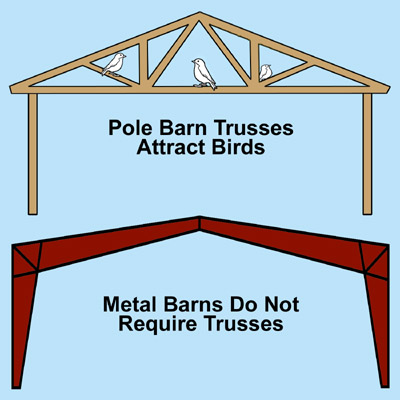Part 6: Pole Barn Trusses vs. Pre-engineered Steel Barn Rafter Beams
Metal barns and pole barns both shelter assets from the weather. Farmers build barns to house and protect expensive equipment, livestock, vehicles, and other possessions from the elements. But when choosing between building pole barns or pre-engineered metal barns, consider what is overhead.
Wood Trusses: An Open Invitation to Wildlife
 Birds of all kinds thrill us with their beauty, chirping, and antics— but no one wants the birds roosting right over their head.
Birds of all kinds thrill us with their beauty, chirping, and antics— but no one wants the birds roosting right over their head.
The trusses used for pole barn kits and other wood-framed structures provide ample space for birds to perch. The cord and crosspieces of each truss invite birds to nest and raise their young in the protection of the building. Soon multiple nests appear throughout the pole barn.
Unfortunately, birds overhead mean frequent deposits of droppings on whatever— or whoever— is housed in the building. Not only is that a disgusting problem, but diseases like Avian Flu are expelled in bird feces.
Metal Web Trusses: Built for the Birds
Some pole barns use a combination of wooden posts with metal web trusses. The intricate “webbing” of light-gauge metal trusses furnishes even more options for birds and other pests to visit— or move in permanently.
Metal Barn Rafters: No Place to Rest or Nest
Pre-engineered steel barns do not require trusses.
Steel is so much stronger than wood, only simple rafter beams are needed to bear the structural load. There is no need for a “cord” connection from side to side. Typically, only two steel columns and two rafter beams are required to make each “frame” of a steel barn or building. Eliminating the need for a cord also means more room overhead in a steel barn or metal building.
The superior strength of steel also means far fewer frames are needed. Pre-engineered metal barns place frames 25’ apart. Pole barns generally place posts 8’-10’ apart.
Why Build a Structure that Attracts Pests?
Birds aren’t the only occupants who use wood trusses for an apartment complex. Squirrels and rodents shelter and nest in wood barns.
Wood-framed barns and structures also attract termites. Fortunately, even the voracious Formosan termites cannot munch on a metal barn.
Steel barns aren’t the only metal structures which benefit from pest-resistance.
Any structure open to the outside benefits from being built with steel. Aircraft hangars, warehouses, indoor riding arenas, picnic pavilions, firehouses, equipment shelters, hay sheds, automotive repair businesses, and tire stores all increases the risk of bird problems when built with wood trusses.
RHINO’s specialists can supply you with more information and a fast, accurate quote on steel barns or any other steel buildings. Call RHINO today at 940.383.9566.
Related Blogs:
- “So What’s the Difference Between Pole Barns and Steel Barns?” Part 1
- “Which Is the Better Buy— Pole Barns or Metal Barns?” Part 2
- Steel Barn vs. Pole Barn: Which Is Easier to Build? Part 3
- Which Costs Less Over Time, a Metal Barn or a Pole Barn? Part 4
- 5 Big Advantages of Steel Barns over Pole Barns- Part 5
